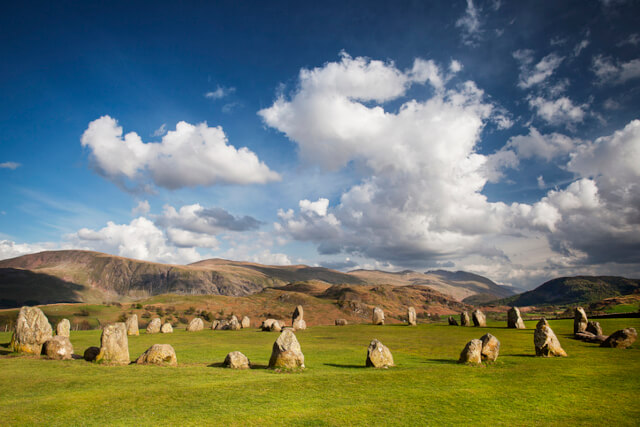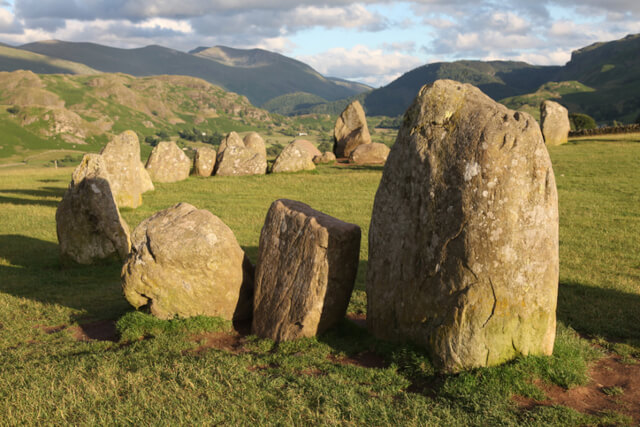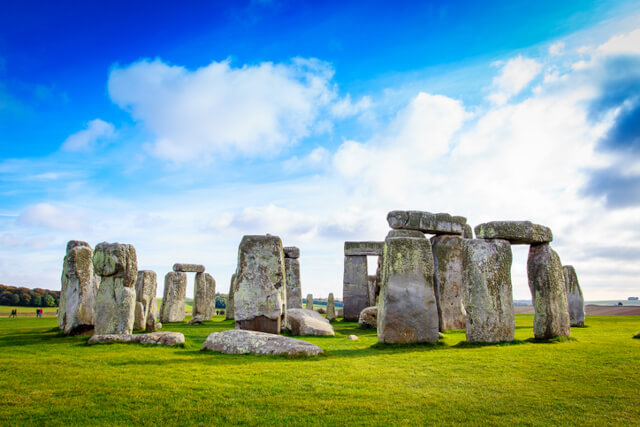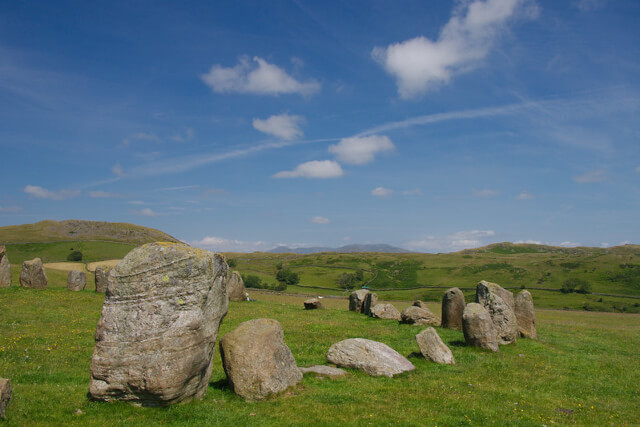One of the few Neolithic stone circles to remain in England, Castlerigg Stone Circle is amongst the most iconic.
In addition to Cumbria’s rocky peaks and glistening waters, it’s quirky stone circles are amongst the Lake District’s most popular points of interest.
A quirky collection of stones positioned high atop a hill, continue reading to learn more about the Castlerigg Stone Circle…
What is the Castlerigg Stone Circle?

Castlerigg Stone Circle is a substantial circle of stone boulders found on the outskirts of the quiet hamlet of Castlerigg.
The circle is thought to have existed as early as 3000 BC, and has since become the most visited stone circle in Cumbria.
This historic stone circle was built as part of a British megalithic tradition, where standing stone boulders were arranged in circles.
Upon its errection, 42 stones made up the 30-metre diameter. Only 38 stones stand today, ranging in height from three to seven foot tall.
History of Castlerigg Stone Circle
With a history dating back as far as 3000 BC, Castlerigg Stone Circle is one of the oldest of its kind.
The stone circle at Castlerigg was one of the earliest monuments in England to be placed under the protection of the Ancient Monuments Protection Act of 1882.
The purpose of this act was to protect and preserve over 68 archaeological and historical sites across Great Britain and Ireland. Nowadays, like many historical monuments across the UK, the site is owned by the National Trust.
There are almost 300 stone circles located across England. But unlike most, this Neolithic monument lacks any evidence of a Bronze Age burial.
Where is Castlerigg Stone Circle?
This English Heritage stone circle sits just east of Keswick, a short distance from Castlerigg.
Surrounded by peaceful Lakeland greenery, visitors are rewarded with panoramic views towards the peaks of Helvellyn and High Seat.
One of the most important and impressive monuments in England, it’s easy to see why Castlerigg Stone Circle is so popular with visitors.
What was Castlerigg Stone Circle used for?
Owing to it’s age, the original purpose of the stone circle cannot be confirmed. Over the years, however, numerous rumours and speculations have been made regarding its purpose.
Much like many similiar stone circles, it is thought that the structure was erected for religious or ceremonial reasons. Built in places considered holy, historic stone circles serve as a centre for worship.
No excavation of the site has ever taken place, however, in 1901 evidence of three Neolithic axes along with chippings of a similar stone were uncovered nearby. This raised the possibility that axe trading may have once taken place on the grounds.
Popular with visitors during solstice celebrations, the stone circle is thought to hold astronomical importance. It is believed that some of the stones are arranged in a solar alignment with lunar positions.
As such, it is likely that this pre-historic monument was built by ancient astronomers.
Getting to Castlerigg Stone Circle
Set just a stone’s throw from the bustling town of Keswick, getting to Castlerigg Stone Circle is an easy task.

If you’re travelling the old fashioned way, there’s a number of walking routes leading to this historic monument.
The quickest, and perhaps least scenic, follows Eleventrees away from the town toward Keswick Climbing Wall. Passing the junction for Castle Lane, you’ll come across a wooden field gate on your right hand side. Just beyond the gate you’ll see the stone circle jutting out of the grass.
If you’re driving, follow the directions to CA12 4RN, looking out for the wooden access gate. Found on the crossroads of Eleventrees and Castle Lane, there’s plenty of roadside parking available nearby.
The Castlerigg Stone Circle Walk
There’s a handful of scenic walking routes leading to this mysterious monument, each showcasing the natural beauty of the National Park.
The walking route from Keswick is amongst the most popular. Following an old railway line, this four-mile circular walk climbs through the Lakeland countryside to before returning via Springs Wood.
There’s plenty of rural delights to see along the way, including Derwentwater, Blencathra and the wooded flank of Latrigg.
The trail typically takes two hours to complete, with some road walking in places. There’s lots of scenic spots to stop for a break along the way, whether to enjoy the view or to indulge in an afternoon picnic.
Is Castlerigg Stone Circle older than Stonehenge?

Castlerigg Stone Circle is considered one of the oldest stone circles in Great Britain. In comparison to Stonehenge, Castlerigg is one of the lesser-known stone circles in England.
Built in 2500 BC, historians believe that Stonehenge could be as much as 500 years younger than Castlerigg Stone Circle.
Stone Circles in Cumbria
Aside from Castlerigg, there’s an interesting collection of mysterious stone circles scattered throughout Cumbria.
Stretching a diameter of 350ft, Long Meg & Her Daughters is the second largest stone circle in the country. The history of Long Meg & Her Daughters dates back to 1500 BC.
It is said that the the circle takes its name from a local witch and her daughters, who were all turned into stone for a violation of the Sabbath.
One of the most impressive stone circles in the Lake District, Swinside stone circle is idylically positioned beside Swinside Fell. 55 stones make up the circle, with 30 still standing today. Only accessible on foot, Swinside is one of the less-visited of its kind.

Birkrigg, a Bronze Age stone circle close to Ulverson, is made up of two concentric rings. It is believed that the history dates between 1400 and 1700 BC, with the outer ring made up of 15 stones and the inner ring of 10.
Arguably one of the smallest stone circles in Cumbria, Castlehowe Scar is a small ring, consisting of 10 boulders and stretching just 7 metres in diametre. It is thought that the remaining stones formed part of a ring cairn.
Fancy uncovering the mystery of Castlerigg Stone Circle? Browse our wonderful range of Keswick cottages and secure your getaway today!
And for more invigorating ways to spend your time in the Lake District, give our guide to the Catbells walk a read!
Images courtesy of: Andrew Hill – (CC BY-SA 2.0)